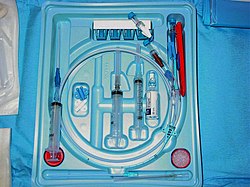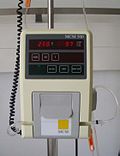Intravenous therapy
Intravenous injection or intravenous therapy means putting liquid into a vein, using a needle. Many illegal drugs and medications can be given intravenously.
Benefits of intravenous injection
Drugs and medications work very fast when given intravenously, because they go right into the bloodstream. They reach the brain and start working in a minute or less. Also, when a drug is given intravenously, 100% of the drug gets into the bloodstream.[1]
When medications are given in other ways, they do not work as fast. Also, not all of the drug reaches the bloodstream.[1]
However, medications given by IV do not last as long as medicines given by mouth As soon as the drug reaches the bloodstream, the body begins to break it down so the body can get rid of it.[2]
Types of intravenous injections
There are two types of intravenous injections.
Single injection
Sometimes, people inject just one drug into a vein with a needle. Then they take the needle out.
When people use illegal drugs like heroin intravenously, they use a single injection. They shoot the drug into their veins, and then take the needle out.[3]
Intravenous line
The second type of IV injection is called an "intravenous (IV) line." This is usually what medical professionals mean when they say a patient is getting an IV.
To do an IV line, a medical professional will:[4]
- Put a needle into the vein
- Slide a hollow plastic tube called a catheter over the needle, and into the person's vein
- Attach the catheter to longer tubes outside the patient's body
- When a patient needs fluids or medications, the medical professional will put the liquid in a bag (called an IV bag) and attach the longer tubes. The liquid then drips through the longer tubes, through the catheter, and into the person's vein
- When a medication needs to be given very quickly, a medical professional can also inject the medication right into the IV line, all at once. This is called an "IV push."
An IV line allows medical professionals to give different liquids at different times, without having to put a needle into a vein every time. They can also give many medications at the same time.[4]
Medical uses
Intravenous lines are often used in emergency medicine. Many things can be given through an IV line.
Volume expanders
Volume expanders are special fluids that are used when a person has lost some of the fluids in their body. For example, a person might lose fluids because of dehydration or bleeding. Volume expanders are used to replace these lost fluids. They are called "volume expanders" because they expand (increase) the volume of liquid in the bloodstream.[5]
Losing too much fluid is dangerous. People need liquid in their bloodstream to carry blood cells, glucose (sugar), electrolytes (salts), and many other important things. Usually, the blood plasma (the liquid part of blood) does this job.[6] However, people can lose plasma for several reasons. For example:[6]
- If a person has heavy bleeding, they will lose a lot of their plasma, along with the things it carries
- If a person gets dehydrated, they will lose some of the water in their plasma. (Normal plasma is 92% water.)
Volume expanders add to the amount of liquid in the bloodstream. They help plasma do its job.[5]
Common volume expanders
There are a few common volume expanders. They are mixtures of liquids and other things the body loses when a person loses fluid:[5]
- Saline: Saline is the most common volume expander. It is a mixture of water and sodium.
- Ringer's Lactate: A mixture of water and five important electrolytes: sodium, chloride, potassium, lactate, and calcium
- D5W: D5W stands for "5% dextrose in water." Dextrose is another name for glucose (sugar). The body needs glucose to make energy. D5W replaces the fluids the person has lost, and also gives them more sugar so they can make energy.
- D5W can also be mixed with saline or Ringer's Lactate to give a person extra electrolytes
Medications
Many medications can be given by IV. They can be given by themselves, or mixed into volume expanders.[6]
Examples of medications that can be given by IV include:[6]
- Some opiate painkillers, like morphine
- Some anti-nausea medications (used when a person is vomiting and cannot swallow medications)
- Some anti-anxiety and antipsychotic medications, like lorazepam and haloperidol (used when people are very anxious, or are psychotic)
- Medications used to put a person to sleep before surgery, like propofol
Blood

Blood transfusions are usually given through an IV line. A blood transfusion can give a person regular blood, or only parts of the blood, like:[7]
- Plasma
- Red blood cells (these are often given alone when a person is very anemic)
- White blood cells (these may be given when chemotherapy kills white blood cells)
- Platelets and/or blood-clotting proteins (given when a person's blood is not clotting well)
Nutrition
If a person cannot eat for a short time, nutrition can be given through an IV line. IV nutrition mixtures include water, electrolytes, glucose, amino acids, lipids (fats), and vitamins.[8]
Intravenous drug use
Intravenous drug use means injecting illegal drugs into a vein. Illegal drugs that can be injected intravenously include:[9]
- Amphetamines
- Barbiturates
- Cocaine and crack cocaine
- Methamphetamine
- Heroin
Sometimes, people also dissolve prescription medications in water and inject them intravenously. For example, some people dissolve oxycodone or benzodiazepines and inject them.[9]
People use drugs intravenously because it is one of the fastest ways to get the effects of the drug. When a person uses drugs intravenously, the drugs start working within 15 to 30 seconds.[9]
Dangers
Using drugs intravenously can cause many problems.
Infections
If a person uses a needle that is not clean to inject drugs, they can get an infection.[3] Common infections caused by IV drug use include:
- Skin infections and abscesses
- Bone infections
- Infection with Staphylococcus aureus bacteria, which can cause:
- Endocarditis (an infection in the heart)
- Bacteremia (infection in the blood)
- MRSA (which is very difficult to treat because many antibiotics do not kill it)
An IV drug user can also get some infectious diseases by using the same needles as people who have those diseases. HIV, hepatitis B, hepatitis C, and many other infections can be spread by sharing needles.[9]
In the world, 40-60% of IV drug users have hepatitis B, and 60-70% have hepatitis C.[9]
Overdose
People are more likely to overdose when they use drugs intravenously. There are a few reasons for this:[3]
- IV drug users will usually inject the entire amount of drugs they want, all at once. This makes it harder to guess how much of the drug they need to get the effects they want. They cannot slowly increase the amount of drugs they use until they get the effects they want. If they accidentally inject too much of the drug, they can overdose.
- Because IV drugs start working so quickly, overdose can happen very quickly.
Problems with veins
When an IV drug user injects drugs into their veins over and over again, they can damage their veins. The veins can get scarred and eventually collapse. This leaves marks over the scarred veins that are called "track marks."[3]
Intravenous TherapyIntravenous Drug Use Media
Saline and 5% dextrose solution (left), levofloxacin 750mg (right), and log sheet hanging from an IV pole
This patient of an intensive care unit of a German hospital could not eat due to a prior surgical operation of the abdominal region which was complicated by a severe sepsis. He received antibiotics, parenteral nutrition and pain killers via automated injection employing syringe drivers (background, right).
An arm board is recommended for immobilizing the extremity for cannulation of the hand, the foot or the antecubital fossa in children.
An infusion pump suitable for a single IV line
Related pages
- Other ways to give medications
- Central venous catheter (a type of IV put into a large vein in the neck, chest, or groin)
References
- ↑ 1.0 1.1 "Pros and cons of different routes of drug administration" (PDF). Doctors.net.uk. Retrieved January 27, 2016.
- ↑ Le, Jennifer. "Drug Absorption". Merck Manual Professional Version. Merck & Co., Inc. Retrieved January 28, 2016.
- ↑ 3.0 3.1 3.2 3.3 "Medical Implications of Injection Drug Use (09HC09)". Center for Continuing & Outreach Education at Rutgers Biomedical & Health Sciences: Online Learning Center. Rutgers University. Archived from the original on March 7, 2016. Retrieved February 16, 2016.
- ↑ 4.0 4.1 "Peripheral Intravenous Access". Department of Emergency Medicine. University of Ottawa. 2003. Archived from the original on February 26, 2016. Retrieved February 16, 2016.
- ↑ 5.0 5.1 5.2 Drake, James W.; Benner, Randall W. (June 13, 2005). "Chapter 3: Intravenous Fluid Selection". IV Therapy for EMS. Prentice Hall. pp. 20-31. ISBN 978-0131186118.
- ↑ 6.0 6.1 6.2 6.3 Sanders, Mick J; McKenna, Kim D; et al. (2011). Mosby’s Paramedic Textbook. Jones & Bartlett Publishers. ISBN 9780323072755.
- ↑ "Types of Transfusions". American Cancer Society. October 7, 2013. Archived from the original on February 5, 2016. Retrieved February 16, 2016.
- ↑ "Home Parenteral Nutrition". Mayo Clinic. Mayo Foundation for Medical Education and Research. October 18, 2014. Retrieved February 16, 2016.
- ↑ 9.0 9.1 9.2 9.3 9.4 Baciewicz, Gloria J. (April 4, 2014). "Injecting Drug Use". Medscape. WebMD, LLC. Retrieved February 16, 2016.










